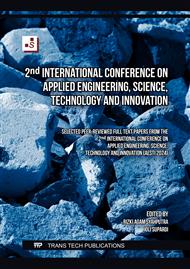[1]
A. Armanini, Principles of river hydraulics. 2017.
DOI: 10.1007/978-3-319-68101-6
Google Scholar
[2]
Research on Hydraulics and River Dynamics. 2023.
DOI: 10.3390/books978-3-0365-5598-0
Google Scholar
[3]
A. Crave and P. Davy, "A stochastic 'precipiton' model for simulating erosion/sedimentation dynamics," Comput Geosci, vol. 27, no. 7, 2001.
DOI: 10.1016/S0098-3004(00)00167-9
Google Scholar
[4]
M. Mossa, D. Termini, and P. Davies, "Turbulence in river and maritime hydraulics," 2018.
DOI: 10.3390/w10070963
Google Scholar
[5]
B. Hankin, P. Metcalfe, K. Beven, and N. A. Chappell, "Integration of hillslope hydrology and 2D hydraulic modelling for natural flood management," in Hydrology: Advances in Theory and Practice, 2020.
DOI: 10.2166/nh.2019.150
Google Scholar
[6]
V. T. Nguyen and F. Nestmann, "Applications of CFD in Hydraulics and River Engineering," in International Journal of Computational Fluid Dynamics, 2004.
DOI: 10.1080/10618560310001634186
Google Scholar
[7]
S. Dutta, "Soil erosion, sediment yield and sedimentation of reservoir: a review," 2016.
DOI: 10.1007/s40808-016-0182-y
Google Scholar
[8]
C. F. Nordin, "Erosion and Sedimentation," Eos, Transactions American Geophysical Union, vol. 52, no. 6, 1971.
DOI: 10.1029/EO052i006pIU292
Google Scholar
[9]
U. C. Kothyari, "Erosion and sedimentation problems in India," IAHS-AISH Publication, vol. 236, 1996.
Google Scholar
[10]
M. Mossa, D. Termini, and P. Davies, "Turbulence in river and maritime hydraulics," 2018.
DOI: 10.3390/w10070963
Google Scholar
[11]
Badan Standarisasi Nasional, Tata Cara Perencanaan Krib di Sungai Bagian 1: Perencanaan Umum, 1st ed., vol. 1. Jakarta: Badan Standarisasi Nasional Indonesia, 2016.
Google Scholar
[12]
T. S. Putri et al., "BETON KRIB POROUS SEBAGAI KONSTRUKSI PERLINDUNGAN DI BELOKAN SUNGAI," SNT2BKL, vol. 1, 2018.
Google Scholar
[13]
M. S. Acharya, "Bamboo River "groynes" Wall: A Sustainable Soil Bioengineering Method to Stabilize Slopesin Nepal," Journal of Development Innovations, vol. 4, no. 1, 2020.
Google Scholar
[14]
R. K. Ahmad Syarif Sukri, " PENGARUH BENTUK KRIB TIPE TIANG TERHADAP POLA ALIRAN," Jurnal STABILITA, vol. 6, no. 3, p.1–8, Nov. 2018.
Google Scholar
[15]
S. Sunaryo and D. Daoed, "PENGARUH PEMASANGAN KRIB PADA SALURAN DI TIKUNGAN 120°," Jurnal Rekayasa Sipil (JRS-Unand), vol. 6, no. 1, p.45, Feb. 2010.
DOI: 10.25077/jrs.6.1.45-54.2010
Google Scholar
[16]
S. Rezeki, E. Fatimah, and M. Masimin, "PENGARUH KRIB TERHADAP KECEPATAN ALIRAN PADA SUNGAI KRUENG ACEH," Jurnal Arsip Rekayasa Sipil dan Perencanaan, vol. 3, no. 4, p.292–301, Dec. 2020.
DOI: 10.24815/jarsp.v3i4.16726
Google Scholar
[17]
M. S. Acharya, "Bamboo River "groynes" Wall : A Sustainable Soil Bioengineering Method to Stabilize Slopes in Nepal," Journal of Development Innovations, vol. 4, no. 1, 2020.
Google Scholar
[18]
A. M. Humairah, "Analisis Hidrolika Bangunan Krib Permeable Pada Saluran Tanah (Uji Model Laboratorium)," Jurnal Teknik Sipil dan Lingkungan, vol. 2, no. 3, 2014.
Google Scholar
[19]
Y. Zhang, L. Song, Y. Bi, B. He, R. Zeng, and T. Li, "Effects of the angle between the rock strata and slope on flow hydraulics and sediment yield in karst trough valley: Laboratory scour experiment," International Journal of Sediment Research, vol. 39, no. 1, 2024.
DOI: 10.1016/j.ijsrc.2023.12.005
Google Scholar
[20]
M. Sudan Acharya, "Bamboo River "groynes" Wall: A Sustainable Soil Bioengineering Method to Stabilize Slopesin Nepal," Journal of Development Innovations, vol. 4, no. 1, 2020.
Google Scholar
[21]
S. Modak and P. Nagarnaik, "Flood Control and Prediction of Flood Using HEC- RAS – A Review," International Journal of Science and Research, vol. 6, no. 3, 2017.
Google Scholar
[22]
D. W. Knight, "River hydraulics - A view from midstream," 2013.
DOI: 10.1080/00221686.2012.749431
Google Scholar
[23]
R. C. Wijaya and R. Rohati, "The Hydraulic Modelling of Capacity of Water Pool in Universitas Jambi," in IOP Conference Series: Earth and Environmental Science, 2019.
DOI: 10.1088/1755-1315/391/1/012072
Google Scholar
[24]
F. Amiri, "Estimate of erosion and sedimentation in semi-arid basin using empirical models of erosion potential within a geographic information system," Air, Soil and Water Research, vol. 3, 2010.
DOI: 10.4137/aswr.s3427
Google Scholar
[25]
R. Chandra Wijaya, "Hydrological Modelling of Bengawan Solo River for Predicting the Hydrology Condition In Watershed Conservation Efforts."
Google Scholar
[26]
N. Mvududu and J. Shannon, "Descriptive Statistics," in Reimagining Research: Engaging Data, Research, and Program Evaluation in Social Justice Counseling, 2023.
DOI: 10.4324/9781003196273-6
Google Scholar
[27]
H. Herrmann and H. Bucksch, "river "groynes" wall," in Dictionary Geotechnical Engineering/Wörterbuch GeoTechnik, 2014.
DOI: 10.1007/978-3-642-41714-6_35417
Google Scholar



